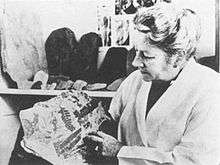Edna P. Plumstead
| Edna P. Plumstead | |
|---|---|
 | |
| Born |
15 September 1903 Cape Town |
| Died |
23 September 1989 (aged 86) Johannesburg |
| Institutions | Bernard Price Institute for Palaeontological Research, University of the Witwatersrand |
| Alma mater | Witwatersrand University |
| Author abbrev. (botany) | Plumst. |
Edna Pauline Plumstead (née Janisch) (15 September 1903 Cape Town – 23 September 1989 Johannesburg) was a South African palaeobotanist, of the Bernard Price Institute for Palaeontological Research, University of the Witwatersrand, Johannesburg. She first began defending the theory of continental drift in the 1950s and has been described as one 'of South Africa's foremost scientists in the field of Gondwana paleobotony and geology'.[1] Plumstead was awarded the Chrestian Mica Gondwanaland Medal by the Geological Society of India, and was made a Fellow of the Royal Society of South Africa.[2]
Edna Plumstead graduated in 1924 from the Witwatersrand University with a B.Sc. (Hons.) in geology and took up an appointment with the Geology Department. Her dissertation for her master's degree was highly regarded by the Geological Society of South Africa leading to her being the first recipient of the Corstorphine Medal. She joined the Bernard Price Institute in 1965 from the Geology Department. At the time she was studying plant fossils collected in Antarctica, and gradually became convinced that sedimentary rocks of the same age in Antarctica, South Africa, South America, India and Australia contained essentially identical plant fossils.
Although this was long before general acceptance of 'continental-drift', plate tectonics and sea-floor spreading, some saw the Antarctic fossil plants as compelling evidence for the existence of the former 'super-continent', Gondwana. Some five years after the palaeobotanical evidence was announced to the world, James Kitching added the evidence of vertebrate fossils to this debate when he joined the United States Antarctic Research Group on a visit in 1970, and collected vertebrate fossils identical to those he was accustomed to finding in the Karoo.
Partial list of publications
- E. P. Plumstead, ‘Description of two new genera and six new species of fructifications borne on Glossopteris leaves from South Africa’, Trans Geol Soc S Afr, 55 (1952), 281–328
- E. P. Plumstead, ‘Bisexual fructifications borne on Glossopteris leaves from South Africa. Palaeontographica, 100B (1956),1–25
- Edna P. Plumstead, Bisexual fructification borne on Glossopteris leaves from South Africa (Stuttgart, E. Schweizerbart, 1956)
- Edna P. Plumstead, Coal in Southern Africa (Johannesburg: Witwatersrand University Press, 1957)
- Edna P. Plumstead, On Ottokaria, the fructification of Gangamopteris (Johannesburg : Hortors Ltd., [1957?])
- E. P. Plumstead, ‘Further fructifications of the Glossopteridae and a provisional classification based on them’, Trans Geol Soc S Afr, 61 (1958), 52–74
- Edna P. Plumstead and R Kraűsel. Fossil floras of Antarctica (London: Trans-Antarctic Expedition Committee, 1962)
- Edna P. Plumstead, Three Thousand Million Years of Plant Life in Africa (Johannesburg: Geological Society of South Africa, 1969)
- Edna P. Plumstead, ‘Plenary paper on Gondwana paleobotany’ (1970)
- Edna P. Plumstead, A new assemblage of plant fossils from Milorgfjella, Dronning Maud Land (Cambridge : British Antarctic Survey, 1975)
References
- 'A Woman's achievement in a man's world: profile of Edna Plumstead' (CSIR, 1970)
- Papers prepared especially in honour of Dr. Edna P. Plumstead (1976)
- R.J. Rayner, ‘Obituaries: Edna Pauline Plumstead (1903-1989)’, International Organisation of Paleobotony Newsletter, 39 (1989), 14-15
- ‘In Memorium: Edna Plumstead’, Sagittarius - Magazine of the South African Museum, 4:4 (December 1989)
- J.M. Maguire, ‘Obituary: Edna P Plumstead (1903-89), South African Journal of Science, 85 (1989), 695-6
- Colin MacRae, Life Etched in Stone: Fossils of South Africa (Johannesburg: Geological Society of South Africa, 1999)
- Prevec, R.; McLoughlin, S and M. K. Bamford. ‘Novel double wing morphology revealed in a South African ovuliferous glossopterid fructification: Bifariala intermittens(Plumstead 1958) comb. nov.’, Review of Palaeobotany and Palynology, 150:1-4 (May 2008), 22-36
- Harufumi Nishida, Kathleen B. Pigg, Kensuke Kudo and John F. Rigby. ‘New evidence of reproductive organs of Glossopteris based on permineralized fossils from Queensland, Australia. I. Ovulate organ Homevaleia gen. nov.’ Journal of Plant Research, Volume 120:4 (July, 2007)